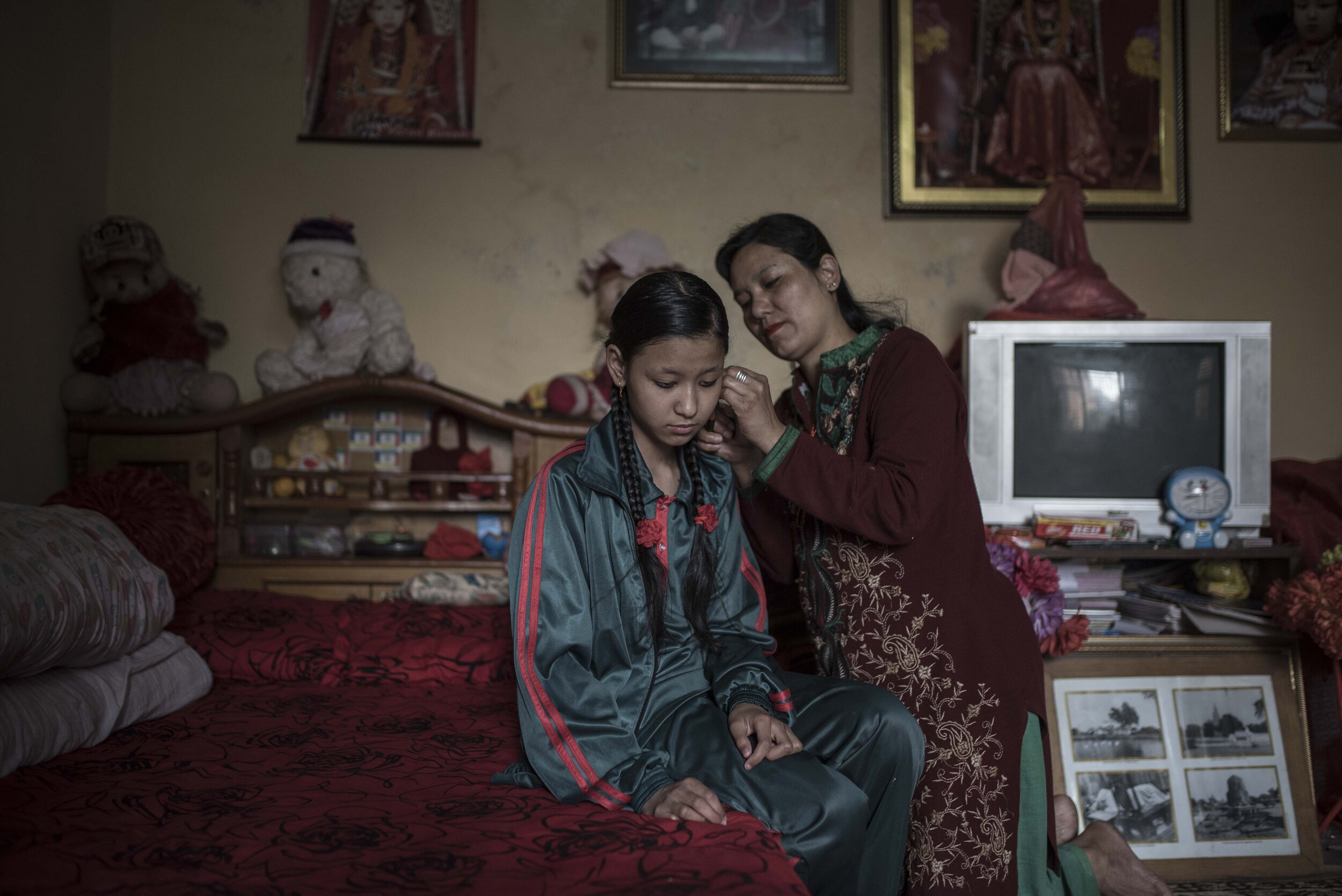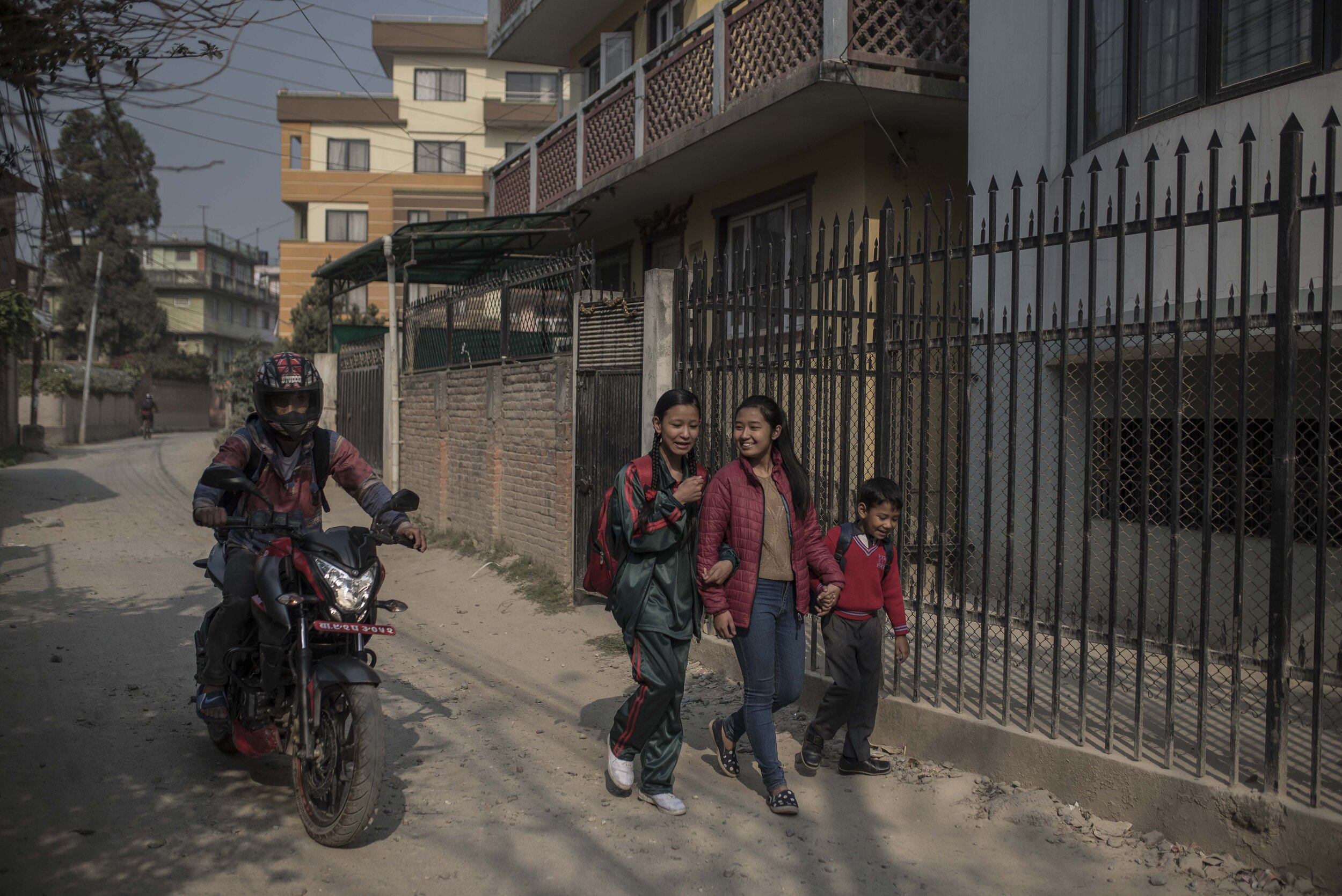Chapter 2: I’m Mortal, Again
Life After Being A Goddess
"What I liked most was to make people happy", says an 11-year-old Unika Bajracharya in her new room in Patan, Kathmandu. After having been the Living Goddess of Nepal for more than 5 years, she was replaced the day she had her first period, in February 2018.
During the past 300 years, a succession of small girls have been chosen to become a Nepal's living Goddess, worshiped for both Hindus and Buddhists. There are a total of 10 living Goddesses, but the most important ones are the Kumari of Kathmandu and of Patan, both in the Kathmandu Valley. Chosen from the 3 to 6 years of age from the Newari ethnic group, they are confined inside a temple. Their relatives and a private teacher are the only ones who can talk to them and they are not allowed to touch the ground with their feet. They both must observe strict rules of purity and segregation, and the practice has come under criticism from human rights activists. They are believed to be the personification of the Goddess Taleju or Devi and to hold a connection with the divine.
Nihira Bajracharya, the Living Goddess of Patan, who is 6 years old, poses for a portrait in the worshiping room of her new home inside the Kumari Temple of Patan, in Kathmandu Valley.
During the Rato Machhendranath Festival in Patan, military march defiles in front of the Kumari of Patan. She has been assigned a privileged place (just behind them), from where she can see all the festivity rituals. This is the larger festival in the city, where a chariot with a God statue is pulled all over the city.
The father of the Living Goddess of Patan applies some makeup to her daughter in her home inside the Kumari Temple of Patan in Kathmandu Valley. The usual Goddess make up is black eyeliner and a big red "tikka" on the forehead, that is believed to awake the 3rd eye and to give power.
Trishna Shakya, the new Kumari of Kathmandu, who was selected in September 2017, is carried by male relatives to assist the Seto Machindranath festival in Kathmandu. This is one of the first times she makes an appearance as a Goddess.
Nihira Bajracharya, the newly selected Living Goddess of Patan, takes her breakfast in her room in Patan with her sister. She can't talk to anyone except her relatives.
Citizens gather to see the Rato Machhendranath festival in Patan, where the Living Goddess is making an appearance.
The now-former Living Goddes of Patan, Unika Bajracharya, is carried home by male relatives to the temple where she lives. This is the only time she is allowed to leave the temple, 13 or 18 times a year, for festival occasions, and has always to be carried.
This Goddess life doesn’t last forever. In the Nepalese culture, menstrual blood is seen as something polluted, and non-divine. Even for a Goddess, menstruation means a change of life. Once a Kumari has her first period, she has to be replaced. "It takes at least one year to be used to it", says Samita Bajracharya, a 16-year-old former Kumari. After her first period, Bajracharya was replaced and had to adjust to a new "mortal life".
"You are a Goddess, and from one day to another, you're just a normal person learning how to take the bus". Simple things like going to school can seem overwhelming at first. For the first time in their lives, they will have to mingle with other kids and learn to live like the humans they once were.
The Kumari of Kathmandu have made an appearance during the Gai Jatra Festival, and citizens had thrown to her high chair rice, flowers, and sweets.
The former living Goddess of Patan, Unika Bajracharya, who is 10 years old, and who has just been replaced four months ago, applies some makeup in her house in Patan. She has been a Kumari for more than 5 years, and she has gotten used to wearing the typical Kumari makeup. “I was happier when I was a Kumari, especially during the festivities”, she says, “I loved to make people happy with my blessings”.
Unika Bajracharya’s mother set her daughter's earnings before a school day. The whole family moved here 4 months ago, after Bajracharya had her first period.
In the Newari community, music is linked with the Gods and their knowledge.
When Unika Bajracharya was a Kumari, she used to play too with the same teacher. For him, it is a huge honor to have been the one who instructed her.
Unika Bajracharya walks with her siblings to the school in Patan, Kathmandu Valley.
Matina Shakya's picture, the 12-year-old former Living Goddess of Kathmandu, who has been recently replaced, along with the picture of the Living God of Kathmandu Valley, is seen in her school entrance. "School where Living God and Goddess are students", is written on the banner.
Matina Shakya, the 12-year-old former Living Goddess of Kathmandu, who has been recently replaced, speaks on the phone with some friends during her school holidays in her home near Durbar Square, in Kathmandu. She has been a Kumari since she was three.
Unika Bajracharya plays with her siblings during a family festivity.
Unika Bajracharya walks along with her Grandmother and the whole family to a temple. Her grandmother just reached 77 years of age. Before the invention and availability of modern medicine, reaching this age was similar to getting a new life, and during this celebration, the grandmother will be worshipped as a Goddess. The only one that doesn’t have to worship her is Unika, who stopped being a Goddess just 4 months ago.
A Unika Bajrachary’s relative plays with a fishbowl during a family festivity.











